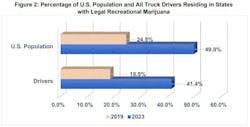A growing number of truck drivers are being exposed to legalized marijuana in their home states, according to a new report from a leading freight-hauling industry research group. While federal law still prohibits professional drivers from recreational or medical use, there are 23% more truck drivers living in marijuana-legalized jurisdictions than just four years ago.
The report by the American Transportation Research Institute (ATRI) joins another notable study released in May by a nationwide chain of drug-testing labs, Quest Diagnostics, that said positive test results for THC (the psychoactive ingredient in marijuana) following on-the-job accidents among the whole U.S. workforce reached a 25-year high in 2022. All the while, the federal Drug & Alcohol Clearinghouse, the repository of test results for all transportation employees nationwide—including truck drivers—saw a 31% jump in marijuana positives last year.
See also: Oral-fluid drug testing on hold
In 2012, Colorado and Washington became the first states to legalize recreational marijuana use. Since then, 19 more states and the District of Columbia have legalized recreational use and 38 plus D.C. have sanctioned it for medicinal purposes. Federal law, though, prohibits use of marijuana for any reason.
Because truck drivers are licensed for interstate commerce, it’s federal law—not state or D.C. law—by which they must abide. And according to new data through April of this year, the federal clearinghouse has, since its inception in 2020, excluded 114,039 CDL-holders after positive marijuana tests until they go through a return-to-duty (RTD) process of counseling, monitoring, and follow-up testing. More widely, 185,520 drivers have tested positive for 14 different ban substances since 2020, according to the April figures, and more than 100,000 have never cleared RTD and thus have given up using their CDLs or are doing so illegally.
The clearinghouse is a secure online database that gives employers, the Federal Motor Carrier Safety Administration, state driver licensing agencies, and state law enforcement near real-time information regarding drug-and-alcohol violations by holders of CDLs and commercial learner’s permits.
ATRI assesses legalization’s spread on trucking
The ATRI study, “Impacts of Marijuana Legalization on the Trucking Industry,” notes the impact that accelerating positive THC tests with the clearinghouse are having on the truck-driver population. A top-level finding notes that 49.8% of the U.S. population—and 41.4% of truck drivers—by the start of 2023 lived in states that have legalized the recreational use of marijuana, according to Bureau of Labor Statistics data. These figures are up from 24.5% and 18.5%, respectively, since the last ATRI report on the subject debuted in 2019.
The ATRI study also pulls out more notable clearinghouse data for the 2020 to end-of-2022 period:
- 57.2% of positive tests for illicit substances were for marijuana.
- 72.6% of drivers with positive test results during that time were still in prohibited status at the start of 2023, and 55% had not initiated the RTD status.
- A mere 4.5% of truck drivers with previous positive tests went on to complete follow-up testing for RTD, indicating that drivers are far more likely to leave trucking than complete the rigors of the return-to-duty process, which can go on for months or even years depending on the situation.
The study’s "summary of workforce implications" also concludes that trucking competes with other industries such as short-haul delivery that do not require drug tests—including for marijuana—and that multiple states recognize use of the drug for medicinal purposes as valid and shield these employees under state law.
The study also surveyed carriers themselves to understand the scale of the conflict between state and federal laws when it comes to marijuana acceptance.
See also: Opinion: Why not hair testing?
Among those freight carriers surveyed, 49,306 of their drivers—or 39.4%—are based in states where marijuana use is legal for recreational purposes compared to 75,799 drivers—or 60.6%—where it is not legal for such use. Also of the carriers surveyed, 43.7% said they would not hire driver candidates with a past positive marijuana test result while 56.3% said they might hire them, though most would only do so after various time periods elapsed.
Also of the surveyed carriers, 60.1% said they noticed an increase in the last five years of positive test results.
Some substances are known to be far more dangerous and addictive when compared to marijuana, the study also notes, but when carriers were asked if they treated violations differently, depending on the drug involved, only 24.4% indicated that some violations were treated differently while 75.6% of respondents said that different drugs were weighted equally in their hiring decisions.
To keep or remove marijuana’s Schedule 1 status
The ATRI study documents strategies and implications of the two pathways the U.S. government could take in response to advancing local legalization: Keep the prohibition where marijuana remains a Schedule I substance (alongside heroin, ecstasy, and LSD), continuing the trend of purging thousands of drivers annually from the industry through positive marijuana tests, or a scenario where the government could ease its rules and possibly remove marijuana’s strict Schedule I designation.
The ATRI study notes: “The federal prohibition of marijuana use by CDL-holders has been highlighted as a potential disincentive for drivers to stay in the industry, and it has even been argued that loosening the restrictions on marijuana use would make the industry more attractive and widen the potential labor pool."
See also: Post-accident positive marijuana results reach 25-year high
However, it says: "It is not definitively known where the thousands of CDL drivers and driver candidates that declined the RTD process ultimately found employment. A greater unknown is the number of potential drivers who have been dissuaded from joining the industry due to pre-employment screening for marijuana. What is clear, however, is that the industry has a long-standing driver shortage; estimates indicate that 65,000 additional truck drivers are needed.”
The report identifies several protections that must be in place for employers in safety-sensitive industries, including the development of a nationally recognized marijuana impairment test and impairment standards as well as provisions that protect a freight carrier’s ability to screen employees for drug use.
The report also notes that the Infrastructure Investment and Jobs Act, signed into law by President Biden in 2021, may increase research and analysis of marijuana’s impacts on roadway safety and that the bipartisan infrastructure law directs the U.S. Department of Transportation to produce a report on marijuana impairment’s effect on operating a vehicle and provide guidance for the public.
Minnesota Trucking Association President John Hausladen told ATRI: “Minnesota recently joined the growing list of states legalizing recreational marijuana. This action underscores the critical need for tools to effectively determine marijuana impairment by current and prospective employees. As an industry committed to workplace and roadway safety, we owe it to ourselves and our families to make sure we can screen to maintain a clean and sober workforce.”
And the ATRI study concludes: "In the past decade legalized recreational marijuana has shifted from limited, novel legislation to a national reality. While there is growing acceptance and availability of the drug in the U.S., there exist significant knowledge gaps regarding the relationship between marijuana use and public safety. The impacts of impairment on individual drivers and overall highway safety have yet to be adequately documented through research."







